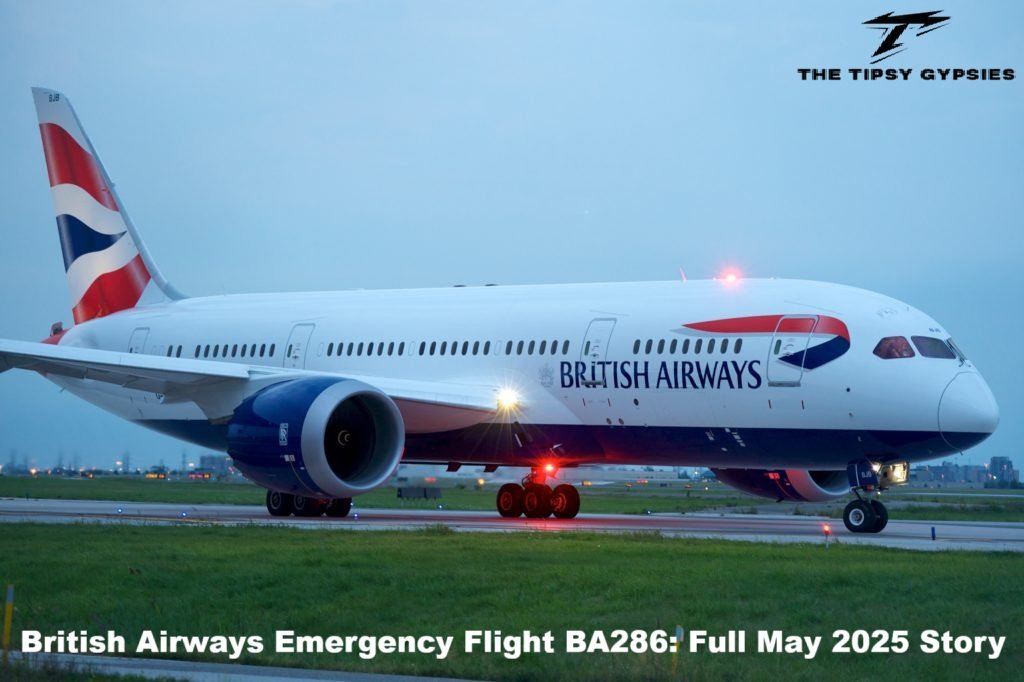The phrase british airways emergency flight ba286 refers to a transatlantic flight in May 2025 when a British Airways Airbus A380 traveling from San Francisco to London declared a general emergency using transponder code 7700 due to a medical situation on board. The aircraft, tail number G-XLEG, was given priority handling and landed safely at Heathrow Terminal 5. Aviation sources confirmed that the disruption was not caused by a technical fault. This event highlights how pilots, air traffic controllers, and ground teams work together under pressure to ensure passenger safety with calm professionalism.
Understanding Flight BA286 and Its Regular Operations
Flight BA286 is a daily long-haul service operated by British Airways. The route serves as a direct link between San Francisco International Airport in the United States and London Heathrow Airport, one of the world’s busiest and most important gateways for international travel. The route plays a key role for business executives, leisure travelers, and tourists, providing a reliable connection between two global cities.
The flight usually departs from San Francisco in the evening, flying overnight across the North Atlantic Ocean, and arriving at London Heathrow’s Terminal 5 the following morning. The aircraft on this route is often an Airbus A380, the world’s largest passenger jet, known for its long-range capabilities, quiet engines, and spacious interior.
The Emergency Incident – May 27, 2025
When and Where It Happened
On May 27, 2025, while flying at cruise altitude over the North Atlantic, the pilots of BA286 entered squawk 7700 into the aircraft’s transponder. This is the universal code used to indicate that the aircraft is experiencing an emergency and needs priority handling.
Why Squawk 7700 Was Declared
In this case, the cause was a serious medical emergency involving a passenger. The flight crew quickly assessed the situation, administered medical aid, and consulted with ground-based doctors via the airline’s telemedicine system. After reviewing the passenger’s condition and available landing options. The captain decided it was safe to continue to London rather than divert to another airport.
The Nature of a Squawk 7700 Alert
When a pilot sets the 7700 transponder code, it signals to air traffic controllers that the aircraft is experiencing an emergency. This code gives the flight priority in the airspace but does not explain the exact type of emergency. It could signal a medical problem, technical fault, fuel issue, or security matter. The priority is to alert all air traffic control sectors that the flight needs immediate support and a clear route to land.
How Air Traffic Control Responds
When a 7700 signal is received, controllers clear the surrounding airspace, redirect other aircraft if needed, and prepare the destination airport for an early arrival. Ground services, such as ambulance crews, paramedics, and airport emergency staff, are placed on standby to provide immediate assistance as soon as the aircraft lands.
For the BA286 incident, the operations team at London Heathrow’s Terminal 5 worked closely with British Airways to ensure that medical professionals were ready at the gate as soon as the aircraft landed. Allowing for immediate assistance to the affected passenger. This planning allowed the passenger to receive treatment within minutes of arrival.
The Aircraft Involved – Airbus A380 G-XLEG
British Airways’ A380 Fleet
British Airways operates twelve Airbus A380-800 aircraft, each designed to carry 469 passengers across four travel classes – First, Club World (Business Class), World Traveller Plus (Premium Economy), and World Traveller (Economy). The A380’s double-deck design provides wide aisles, multiple galleys, and spacious cabin areas that can be rearranged for medical or operational needs.
Emergency-Friendly Design
The Airbus A380 is particularly well-suited to managing in-flight medical events. It has large crew workspaces, room for passengers to be treated discreetly, and equipment storage areas that can be quickly accessed. The aircraft is also quieter and more stable in flight. Making it easier for crew and onboard medical professionals to work effectively.
Crew Training and Onboard Medical Equipment
British Airways trains all cabin crew extensively in first aid, CPR, oxygen administration, and the use of automated external defibrillators (AEDs)</strong>. Each long-haul aircraft carries emergency medical kits, portable oxygen bottles, stretchers, and other necessary items.
In addition, the airline uses MedLink or similar telemedicine services, which connect crew with specialist doctors on the ground. This allows real-time advice to be given, helping the captain decide whether to divert the aircraft or continue to the destination.
Why the Flight Continued to London
The choice to continue instead of diverting was based on several factors. First, the passenger’s condition had been stabilized by trained crew and a volunteer medical professional on board. Second, Heathrow offers world-class emergency facilities, which meant that the patient would likely receive better care upon arrival there than at a smaller diversion airport. Third, continuing avoided the additional stress of landing and re-boarding for all passengers.
Timeline of Events
ata-end=”5941″>Evening of May 26, 2025 – BA286 departs San Francisco International Airport on schedule.
>Morning of May 27, 2025 (UK time) – The crew declares squawk 7700 over the North Atlantic after a medical situation develops.
Approach to London – Air traffic control clears Heathrow runways, informs emergency responders, and prepares Terminal 5.
Landing – The aircraft lands safely. Medical teams board immediately to assist the passenger.
Post-Landing – No technical problems are found. The emergency is confirmed to be medical in nature.
How Airlines Manage In-Flight Medical Emergencies
Preparation and Readiness
Airlines have detailed medical protocols for dealing with emergencies at altitude. The aim is to stabilize the patient until professional care is available on the ground. Equipment is stored in locations that can be accessed within seconds, and crew members practice emergency scenarios regularly.
The Divert or Continue Decision
The captain, in consultation with the lead flight attendant and ground-based medical professionals, must decide whether to divert. Factors include the severity of the patient’s condition, distance to the nearest airport, and whether that airport has the medical resources to handle the case.
Role of the Destination Airport
Major hubs like Heathrow maintain Emergency Response Plans (ERPs)</strong>. These plans ensure that, in situations like BA286, paramedics, doctors, and security teams are ready at the gate before the aircraft even touches down.
Passenger Rights When a Flight Is Disrupted by a Medical Emergency
-start=”7549″ data-end=”7724″>Under UK Regulation 261, passengers affected by a disruption caused by a medical emergency are entitled to assistance but not necessarily financial compensation</strong>.
Assistance Provided
Passengers may receive meals, hotel accommodation if needed, and rebooking onto another flight. These measures are offered regardless of whether the airline was at fault.
Why Compensation Is Not Usually Paid
Medical emergencies are considered extraordinary circumstances under UK and EU law. This means that, while the airline must take care of passengers, it is not legally required to pay compensation. Because the disruption was outside its control.
Passenger Advice
If you are affected, keep all travel documents, boarding passes, and receipts for any extra expenses. These will help if you need to make a claim for reimbursement of assistance-related costs.
The Passenger Experience During BA286’s Emergency
Travelers reported that the cabin atmosphere remained calm throughout the incident. Crew members discreetly attended to the passenger in need, using oxygen equipment and coordinating with the cockpit. As the aircraft taxied to its stand, passengers noticed emergency vehicles already waiting, and the handover to medical professionals was swift and professional.
Previous BA286 Emergency History
BA286 has experienced emergencies before, though unrelated to the 2025 event. In October 2016, another BA286 flight from San Francisco diverted to Vancouver after multiple crew members became unwell. All were taken to hospital and later discharged. While the two incidents have no connection, the repetition shows that passengers often follow this route closely, and that crews are prepared for unexpected situations.
Conclusion
The British Airways emergency flight BA286 in May 2025 is a strong example of how modern air travel deals with unexpected situations with skill, teamwork, and care. What began as a routine overnight flight from San Francisco to London became a serious test of preparedness when a medical emergency happened during the journey.
By declaring squawk 7700, the crew made sure air traffic control, airport teams, and medical responders were immediately informed and ready. The choice to continue to Heathrow instead of diverting was based on a careful medical assessment. Ensuring the passenger’s safety and making use of the advanced medical facilities available on arrival.
In the end, the emergency was handled with calm professionalism. There were no technical issues, and everyone on board reached their destination safely. This incident strengthened trust in highly trained crews, reliable aircraft like the Airbus A380. And the well-structured safety systems that make air travel one of the safest ways to travel in the world.
Frequently Asked Questions ( FAQs )
What was the British Airways emergency flight BA286?
May 27, 2025 service from San Francisco to London that declared squawk 7700 due to a medical emergency on board. The Airbus A380 G-XLEG landed safely at Heathrow Terminal 5.
Why did BA286 declare squawk 7700?
Because a passenger experienced a serious medical problem that required immediate priority handling by air traffic control.
Was the emergency due to a technical fault?
No. It was confirmed to be a medical incident, and the aircraft continued its journey without any mechanical issues.
Did BA286 divert to another airport?
No. The passenger’s condition was stable enough to continue, and Heathrow had superior medical facilities ready upon arrival.
What rights do passengers have in such cases?
Passengers are entitled to care and assistance, including meals, hotels, and rebooking. But usually not financial compensation, as medical emergencies are outside the airline’s control.






